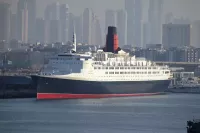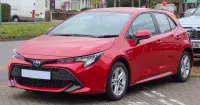The RMS Titanic, a British ocean liner, sank on April 15, 1912, after hitting an iceberg during its maiden voyage from Southampton to New York City. Approximately 1,500 of the 2,224 passengers and crew perished, marking it as one of history's deadliest peacetime maritime disasters. Operated by White Star Line, the Titanic carried both wealthy individuals and emigrants seeking a better life in North America. The tragedy led to significant reforms in maritime safety regulations and has had a lasting impact on popular culture. It was the second time White Star Line had lost a ship on her maiden voyage.
June 1907: Oceanic's departure from Southampton
In June 1907, RMS Oceanic first departed from a new home port in Southampton along with the Teutonic, Majestic, and the new Adriatic on the Southampton-New York run.
1907: Captain Smith's Confidence in Modern Shipbuilding
In 1907, Captain Smith stated he could not imagine any condition that would cause a ship to founder, highlighting the confidence in modern shipbuilding at the time. This came after an incident where SS Kronprinz Wilhelm, a German liner, had rammed an iceberg but still completed the voyage.
1907: Discussion about Olympic-class liners
In mid-1907, J. Bruce Ismay, chairman of the White Star Line, and J.P. Morgan, who controlled the White Star Line's parent corporation, discussed the construction of a new class of liners.
July 1908: Design Approval and Construction Authorization
On July 29, 1908, Harland and Wolff presented the drawings to J. Bruce Ismay and other White Star Line executives, and Ismay approved the design. On July 31, 1908, Ismay signed three 'letters of agreement', authorizing the start of construction of the Olympic-class liners.
December 1908: Keel Laid Down for Olympic
On December 16, 1908, the keel for the Olympic was laid down, marking the start of its construction.
March 1909: Keel Laid Down for Titanic
On March 31, 1909, the keel for the Titanic was laid down, beginning its construction.
May 1911: Titanic's Launch
On May 31, 1911, Titanic was launched at 12:15 pm in Belfast. The ship was towed to a fitting-out berth where the engines, funnels and superstructure were installed and the interior was fitted out.
June 1911: Olympic Enters Service
In June 1911, the Olympic entered service and replaced Teutonic.
September 1911: Collision of the Olympic
In September 1911, the Olympic was involved in a collision, which caused a temporary pause in the construction of the Titanic.
1911: RMS Olympic Rammed
In 1911, RMS Olympic was rammed. Stewardess Violet Jessop and stoker Arthur John Priest, who survived the sinkings of both the Titanic and HMHS Britannic, were aboard.
1911: White Star Dock Opens
In 1911, the deep-water dock at Southampton, known as the 'White Star Dock,' opened to accommodate the new Olympic-class liners.
January 1912: Insurance Policy for Titanic and Olympic
In January 1912, Titanic and Olympic were insured through Lloyd's of London and London Marine Insurance for £1,000,000 per ship. The premium for the one-year policy was £7,500, negotiated by Willis Faber & Company. Lloyd's later paid the full sum owed to the White Star Line within 30 days after the sinking.
February 1912: Titanic in Thompson Graving Dock
In February 1912, the Titanic was pulled into Thompson Graving Dock to receive its propellers and final red hull coating.
March 1912: Olympic repairs
On March 6, 1912, the Titanic was moved out of Thompson Graving Dock to allow the Olympic to enter for repairs after losing a propeller blade.
April 1912: Titanic's Maiden Voyage Begins
In April 1912, Titanic's maiden voyage commenced from Southampton. Passengers, including 179 First Class, 247 Second Class, and 494 Third Class, boarded the ship after arriving via the London and South Western Railway's boat train. Third Class passengers were inspected for ailments before boarding.
April 1912: Sinking of the Titanic
In April 1912, the British ocean liner RMS Titanic sank in the early hours of April 15th after striking an iceberg on its maiden voyage from Southampton to New York City. Approximately 1,500 of the estimated 2,224 passengers and crew died, making it one of the deadliest peacetime maritime disasters. The event spurred major changes in maritime safety regulations and left a lasting legacy.
April 1912: Titanic's Sea Trials
On April 2, 1912, Titanic's sea trials began, involving stokers, crew members, company representatives, and a Board of Trade surveyor to ensure the ship's fitness for passengers. Jack Phillips and Harold Bride also performed fine-tuning of the Marconi equipment during the trials.
May 1912: RMS Oceanic Recovers Bodies
In mid-May 1912, RMS Oceanic recovered three bodies over 200 miles from the site of the sinking who were among the original occupants of Collapsible A. The bodies were subsequently buried at sea.
June 1912: Guglielmo Marconi Gives Evidence
In June 1912, Guglielmo Marconi testified before the Court of Inquiry regarding telegraphy. The final report recommended that all liners carry the system and maintain a constant service with sufficient operators.
August 1912: Liner Corsican Strikes Iceberg
In August 1912, the liner Corsican struck an iceberg in the Atlantic, severely damaging the bow. Due to hazy weather, the ship's speed was reduced, limiting further damage. Lifeboats were deployed but not boarded.
December 1912: Titanic's Voyage Schedule
The planned schedule of voyages through December 1912 for the Titanic existed, outlining trans-Atlantic crossings between Southampton and New York via Cherbourg and Queenstown.
1912: Coal Strike Disrupts Shipping Schedules
In 1912, a national coal strike in the UK caused considerable disruption to shipping schedules, leading to the cancellation of many crossings. Despite the strike ending shortly before Titanic's scheduled departure, the ship was only able to sail because coal was transferred from other vessels in Southampton and from the Olympic.
1912: Titanic's Maiden Voyage Cargo
In 1912, during Titanic's maiden voyage, the ship carried baggage, furniture, foodstuffs, and a 1912 Renault Type CE Coupe de Ville motor car as cargo. There were no gold, exotic minerals, or diamonds on board.
1912: Titanic in White Star Line's Fleet
In 1912, the RMS Titanic was part of White Star Line's fleet, which consisted of 29 steamers and tenders. Titanic was one of the three Olympic-class ocean liners.
1912: Radio Act of 1912 passed in the United States
In 1912, the United States government passed the Radio Act of 1912. This act along with the International Convention for the Safety of Life at Sea mandated 24-hour radio communications on passenger ships with a secondary power supply and required ships to maintain contact with vessels in their vicinity, as well as coastal onshore radio stations. In 1912, it was also agreed that firing red rockets from a ship must be interpreted as a distress signal.
1913: Formation of the International Ice Patrol
In 1913, the International Ice Patrol was formed and internationally funded as a direct consequence of the Titanic disaster. This agency of the U.S. Coast Guard monitors and reports the location of icebergs in the North Atlantic Ocean.
May 1914: New "Rules for Life Saving Appliances" passed
In May 1914, as a consequence of the Titanic disaster, the British Board of Trade passed new "Rules for Life Saving Appliances".
June 1914: Application of new rules
In June 1914, the new "Rules for Life Saving Appliances" passed in May were applied at a meeting of British steamship companies in Liverpool.
1914: United States Supreme Court Ruling
In 1914, the United States Supreme Court ruled in favor of White Star Line, determining that the company qualified as a limited liability company (LLC) and that the sinking was largely unforeseeable rather than due to negligence. This decision limited the damages survivors and family members were entitled to.
December 1915: Settlement Agreement Reached with Claimants
In December 1915, a settlement agreement was reached with 44 claimants against the White Star Line, amounting to $664,000. The settlement allocated $500,000 for American claimants, $50,000 for British claimants, and $114,000 for interest and legal expenses.
1955: Publication of A Night to Remember
In 1955, the first historically accurate book about the Titanic disaster, A Night to Remember, was published.
1958: Release of A Night to Remember film
In 1958, the British film A Night to Remember was released and is still considered the most historically accurate movie portrayal of the Titanic sinking.
1969: Queen Elizabeth 2 Registered in Southampton
In 1969, the Queen Elizabeth 2 was one of the first ships registered in Southampton, marking a shift from Liverpool as the primary port of registry.
1974: New version of the Safety of Life at Sea Convention adopted
In 1974, a completely new version of the International Convention for the Safety of Life at Sea, which was created after the Titanic disaster, was adopted.
September 1985: Titanic Wreck Located
On September 1, 1985, a Franco-American expedition led by Jean-Louis Michel and Robert Ballard successfully located the wreck of the Titanic. The wreck lies over 12,000 feet below the surface, where the water pressure is extreme.
1985: Discovery of the Titanic Wreck
In 1985, the wreck of the Titanic was discovered by a Franco-American expedition led by Jean-Louis Michel and Robert Ballard. The discovery revealed that the ship had broken in two before sinking, contrary to the prior belief that it sank in one piece.
1995: Queen's Island renamed Titanic Quarter
In 1995, Queen's Island was renamed Titanic Quarter after the Titanic.
1997: Grand Staircase Replica in James Cameron's Titanic
During the filming of James Cameron's Titanic in 1997, the replica of the Grand Staircase was ripped from its foundations by the force of the inrushing water on the set.
1997: Release of James Cameron's Titanic
In 1997, James Cameron's film Titanic was released and became the highest-grossing film in history and won 11 Oscars.
2001: UNESCO Convention on the Protection of the Underwater Cultural Heritage
In 2001, the UNESCO Convention on the Protection of the Underwater Cultural Heritage was established, providing a framework for state co-operation to prevent unscientific or unethical interventions at ancient shipwreck sites like the Titanic.
2004: Photos showing possible human remains near Titanic's stern
In 2004, Robert Ballard took photos showing a boot and coat close to Titanic's stern which experts called "compelling evidence" that it is the spot where somebody came to rest.
2004: Northern Ireland Tourism Board's Strategic Framework for Action
In 2004, the Northern Ireland Tourism Board's Strategic Framework for Action 2004–2007 identified that interest in Titanic was not being fully exploited as a tourist attraction.
2006: Estimated Collapse of Titanic's Hull
In 2006, it was estimated that within 50 years, the hull and structure of Titanic would eventually collapse entirely, leaving only the more durable interior fittings intermingled with rust due to iron-eating bacteria.
2007: Northern Ireland Tourism Board's Strategic Framework for Action
In 2007, the Northern Ireland Tourism Board's Strategic Framework for Action 2004–2007 identified that interest in Titanic was not being fully exploited as a tourist attraction.
May 2009: Death of the Last Living Survivor
In May 2009, Millvina Dean, the last living survivor of the Titanic and the youngest passenger on board at only nine weeks old, died at the age of 97.
April 2012: Possible Human Remains Discovered
On April 16, 2012, the day after the 100th anniversary of the sinking, photos were released showing possible human remains on the ocean floor near Titanic's stern. The photos were taken in 2004 and showed a boot and a coat.
2012: Opening of Titanic Belfast visitor attraction
In 2012, the Titanic Belfast visitor attraction was opened on the site of the shipyard where Titanic was built.
2012: Centenary of the Titanic disaster marked
In 2012, the centenary of the Titanic disaster was marked by plays, radio programs, parades, exhibitions, special trips to the site of the sinking, commemorative stamps and coins. Royal Mail issued ten 1st class UK postage stamps.
2014: Value of Benefit Concerts in 1912 adjusted for inflation in 2014
In 1912 benefit concerts by Enrico Caruso and Mary Garden and members of the Metropolitan Opera raised $12,000 for victims of the Titanic disaster. The adjusted value in 2014 was $300,000.
November 2016: Construction of Titanic replica begins
In November 2016, a Chinese shipbuilding company commenced construction to build a replica ship of the Titanic for use in a resort.
2016: Titanic Belfast visitor attraction visitation numbers
In 2016, the Titanic Belfast visitor attraction was Northern Ireland's second most visited tourist attraction with almost 700,000 visitors.
August 2018: Groups vie for right to purchase Titanic relics
In August 2018, several groups were vying for the right to purchase the 5,500 Titanic relics that were an asset of the bankrupt Premier Exhibitions.
October 2018: Consortium purchases Titanic relics
On 17 October 2018, a consortium of three hedge funds—Apollo Global Management, Alta Fundamental Advisers, and PacBridge Capital Partners—paid US$19.5 million for the collection of Titanic relics.
2018: Adjusted value for claims against White Star Line
Claims against White Star Line in 1914 totalled $16,804,112, which is approximately $419 million in 2018 USD.
August 2019: Submersible Crashes into Titanic Wreck
Between July 29 and August 4, 2019, a two-person submersible vehicle conducting research and filming a documentary crashed into the wreck of the Titanic due to strong currents. The submersible sustained a red rust stain, but the report did not mention if the Titanic sustained damage.
2022: Titanic replica construction status
As of 2022, the Titanic replica construction was reportedly only 25% complete.
2022: Magellan Ltd. Conducts Six-Week Expedition
During the summer of 2022, Magellan Ltd. conducted a six-week expedition using two submersibles, Romeo and Juliet, to capture 715,000 3D images of the Titanic wreckage and debris field.
May 2023: "Digital Twin" of Titanic Created
In May 2023, Magellan Ltd. announced they had created a "digital twin" of the Titanic, showing the wreckage in unprecedented detail. The model was created from 715,000 3D images captured in the summer of 2022 using two submersibles, Romeo and Juliet.
June 2023: Submersible Titan Implodes
On June 18, 2023, the submersible Titan, operated by OceanGate Expeditions, imploded in the North Atlantic Ocean while carrying tourists to view the wreckage of the Titanic.
July 2024: RMS Titanic Inc. Expedition to the Wreck
On July 15, 2024, RMS Titanic Inc. held their first expedition to the wreck in 14 years, aiming to examine its status with high-resolution photography for future scientific studies and search for on-site artifacts. The expedition utilized a magnetometer for metal detection for the first time.
2024: Value of La Circassienne au Bain in 2024
In 2024, the claimed value of the oil painting La Circassienne au Bain lost on the Titanic was equivalent to $2,300,000.
Mentioned in this timeline

Liverpool is a port city and metropolitan borough located in...
The United States of America is a federal republic located...

The Queen Elizabeth QE a retired British passenger ship is...

A car also known as an automobile is a wheeled...

Books are a means of storing information as text or...

Rust is a reddish-brown iron oxide formed by the reaction...
Trending
Kelvin Sheppard is an American football coach and former NFL linebacker He is currently the defensive coordinator for the Detroit...

Cris Carter is a former American football wide receiver renowned as one of the greatest in NFL history His career...

23 days ago Jonathan Kuminga Trade Rumors: Warriors, Pacers Considering Deals for Forward.

9 months ago Warriors defeat Bucks as Curry rests; Butler III shines in shocking victory.
2 months ago Wole Soyinka's US Visa Revoked: Nobel Laureate Speaks Out Against Travel Ban.

20 days ago Naji Marshall Scores 18 Points and 8 Rebounds in Mavericks Win Against Clippers.
Popular

Ben Shapiro is a prominent American conservative political commentator media...

XXXTentacion born Jahseh Dwayne Ricardo Onfroy was a controversial yet...

Candace Owens is an American conservative political commentator and author...

William Franklin Graham III commonly known as Franklin Graham is...
The Kennedy Center Honors are annual awards recognizing individuals and...

Tucker Carlson is an American conservative political commentator known for...